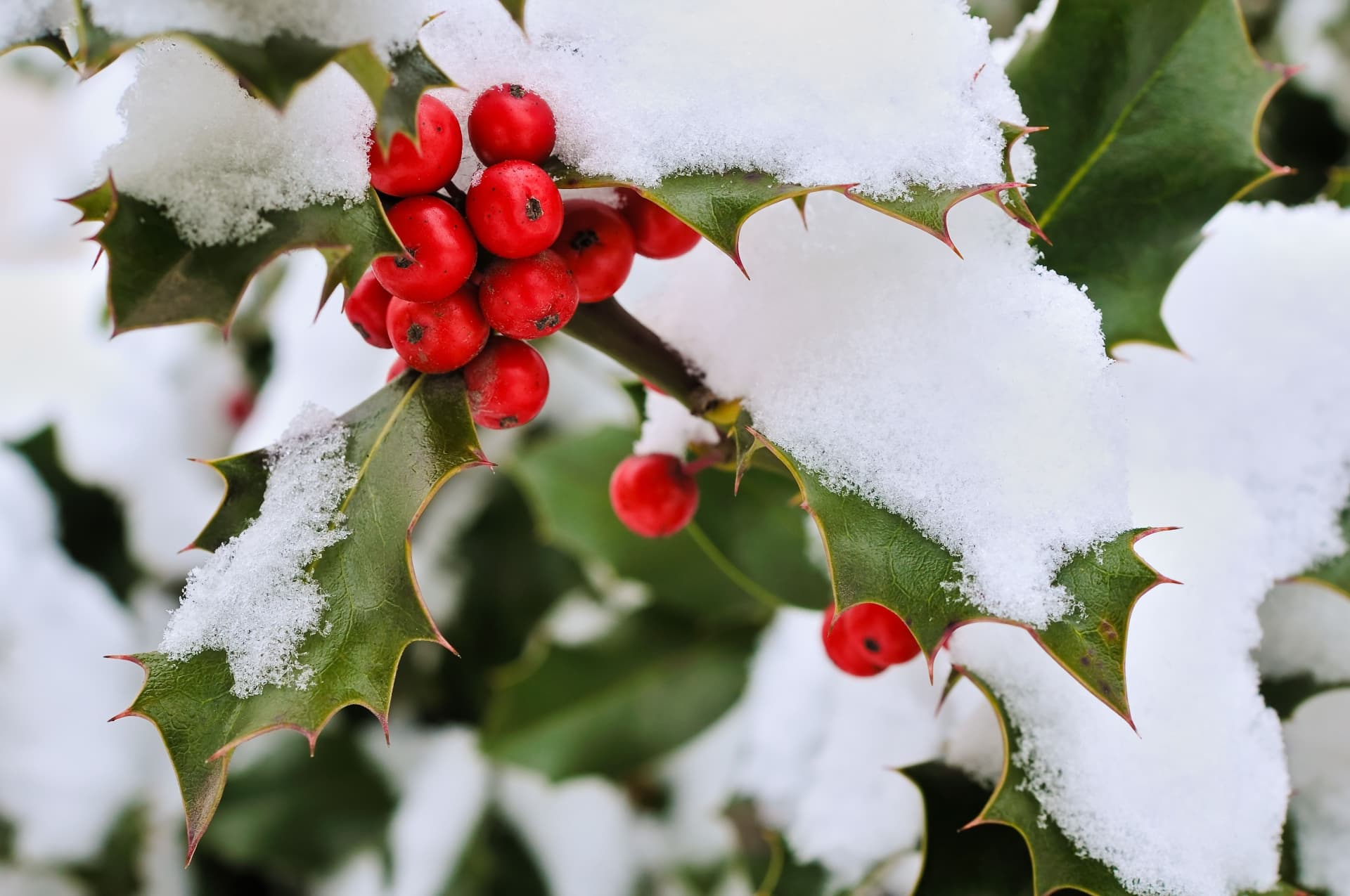The Christmas carol The Holly and the Ivy has been a much-cherished part of Christmas traditions in this country since the 1700s. But what is the significance of this beautiful evergreen?
Holly and ivy have a long association with the Pagan winter solstice. Holly represents the man and the ivy the woman; the two coming together made powerful fertility magic. The tradition of bringing sprigs of holly into our living space in the winter goes back to the time of the Celts who brought holly indoors in the belief that it sheltered woodland fairies. Holly and ivy were also taken inside over winter as a symbol of good luck; it was hoped that by so doing, the occupants would survive the winter, as this hardy foliage does.
Holly is also strongly associated with Christianity; its prickly leaves symbolic of Christ’s crown of thorns, the crimson berries a symbol of his blood, and the evergreen branches a metaphor for life after death. The ivy symbolises Mary. Superstition however, decrees that all decorations, including the holly and ivy, must be taken down by Twelfth night (6 January). Failure to do so will bring bad luck and for some, a ceremonial burning or burying of the holly and ivy is also required.
So, what is required to grow holly successfully?
Apart from their religious connotations, Holly trees are very useful evergreen trees to grow in our gardens or in a large pot. Most hollies will grow in partial shade or full sun – which produces the best leaf colour in variegated varieties. According to the RHS, hollies will grow in moist, but well drained, moderately fertile humus-rich soil. Whilst they prefer a slightly acidic soil, they will grow well in neutral soil but do not particularly care for alkaline conditions. The genus compromises of over 400 species of evergreen and deciduous varieties coming from tropical, subtropical and temperate regions of the world. With a variety of leaf types from spine-toothed, spiny or entire, there are varieties to suit various types of situations and uses.
In the UK, the Common or English Holly, Ilex aquifolium, is frequently found growing happily in churchyards, woodlands, parks and even gardens but it does need space as it can reach up to 25m tall with a girth of up to eight metres. If you are looking for a much smaller, evergreen variety, opt for Japanese Holly (Ilex crenata) which can be used instead of box (buxus) as it is disease resistant, with small leaves that are easily trimmed to shape. Common Holly (Ilex x altaclerensis) is a popular choice as it has numerous varieties, many with variegated leaves. You may also look out for the deciduous varieties which, whilst they lose their leaves in winter, retain many red berries attractive to birds as a food source. They will also grow in damp soil conditions.
When choosing a holly, you will need to understand the rather confusing names given to male and female varieties. To ensure that you get winter berries, you need cross pollination of the flowers in May and June, so plant a male and a female variety which bloom at the same time. Golden Queen is a male variety, whilst Golden King is actually female. Berries form on female plants in late autumn to mid-winter. It is also possible to buy some varieties which have both the male and female plants grafted onto the same rootstock.
The best time to plant a holly of any variety is between November and February, making it a great plant to buy for your garden at Christmas. As easy to grow, they can be slow to start with. Use them as evergreen specimens, clipped bushes in the ground or in pots and as hedges. Most are varieties sold in the UK are hardy and they can tolerate exposed sites.
To plant your holly, dig a generous hole larger than the pot size to give the roots the chance to establish themselves. Incorporate well-rotted garden compost or well-rotted organic matter into the planting hole, back fill and firm down gently around the plant base. The best time to feed is either in spring or autumn, using a mulch of well-rotted organic matter, garden compost or broadleaf evergreen fertiliser. If the winter is not wet, remember to water the new plant well, and water as required during summer.
Hollies can be grown from seeds collected from the berries from December to February. Remove the flesh of the berries and rinse the small seeds. Plant into compost and leave to germinate outdoors. You can also take semi-ripe cuttings in August and September when conducting formative pruning. Hardwood cuttings can be taken in winter.
When it comes to pruning, this should be undertaken in late summer before the new growth becomes woody. If a holly tree needs to be reshaped entirely, stagger the hard pruning over a two or three year period.
Hollies are generally robust and easy to grow. However, they can become affected by holly leaf blight, which is a fungal infection of the leaves, caused by Phytophthora ilicis. This causes discolouration to the leaves and stems and loss of foliage. The fungus, believed to have come from North America, thrives in cool, damp conditions. Whilst there is no direct treatment, if you identify blotchy leaves, cut out the infected area and burn the trimmings to stop it spreading. When purchasing new hollies, as a precaution keep them separate from others in the garden and under close observation for a couple of months to ensure they are free from blight before planting.
Your plants may also be affected by holly leaf miner, a small fly whose larvae causes patches and blotches by feeding inside holly leaves. Although it does not actually harm the plant, it does look unsightly. Remove affected leaves and destroy them.
Whilst the holly berries provide a good source of food for birds, they are very toxic to humans and dogs. Holly trees provide dense cover and good nesting places for birds, whilst the plants dry leaf litter is used by hedgehogs and small mammals for hibernation. In early summer, their flowers provide nectar and pollen for bees and pollinators. Smooth leaves found at the tops of holly trees are also a tasty source of winter food for deer.








